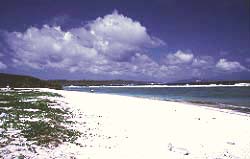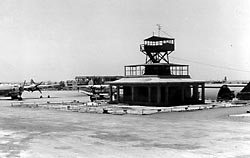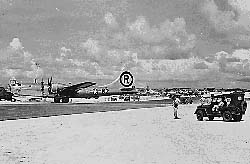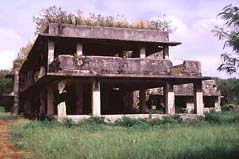
The Tinian Landing Beaches, Ushi Point Field, and North Fields, Tinian Island are recognized for the role they played in World War II. The capture of Tinian, one of the Marianas Islands, in the summer of 1944 from Imperial Japan by U.S Marines provided American forces with a valuable airstrip from which to mount raids on Japan; ultimately, the islands served as the base from which the atomic bomb attacks on Hiroshima and Nagasaki were staged.
By selecting almost impossibly small landing beaches during their assault on Tinian, the Marines confused Japanese commanders and established a beachhead at little cost in lives. Despite the narrow beaches (a total of 180 yards in width), two Marine divisions succeeded brilliantly in a difficult amphibious operation. Lt. Gen. Holland M. Smith, USMC, called this "the perfect amphibious operation in the Pacific War." In the first night of the battle, at 2am on July 25, the Japanese employed their usual tactic of attempting to destroy the enemy on the beach. It was a fatal effort for it cost them up to 2,000 lives, including some of their best infantry troops. Future battles would see the Japanese defenses arranged in depth, inflicting heavier casualties on the Americans.

The U.S. Marines' assault on Tinian was considered to be Phase III of Operation FORAGER which began with the capture of Saipan (Phase I) and the battle for the liberation of Guam (Phase II) which was raging even as the Marines approached Tinian. Under the overall command of Admiral Chester W. Nimitz at Pearl Harbor, Admiral Raymond K. Turner, as commander of the Joint Expeditionary Force, was responsible for both the Northern Attack Force (Task Force 52, Saipan and Tinian) and the Southern Attack Force (Task Force 53, Guam). He had relinquished direct control of the Northern Attack Force by the time of the Tinian invasion to rear Admiral Harry W. Hill. The Japanese forces made their last stand on a plateau at the southern and southeastern end of Tinian. After naval and aerial bombardment and fierce fighting by the Fourth Division of U.S. Marines, the Japanese military presence ended on Tinian with 5,500 dead and 404 taken prisoner. The Second Marine and Fourth Marine Divisions had a total loss of 355 killed, 1,550 wounded and 27 missing in action. More than 13,000 civilians, mostly Japanese, were interned on Tinian until the end of the war.

Tinian's topography provided the U.S. Army Air Force with a superb platform for constructing two long-range B-29 bomber airfields, including North Field, the largest airfield in the Pacific and perhaps in the world during World War II. From Tinian's six runways, as well as from bases on Saipan and Guam, armadas of B-29s raided and destroyed Japanese cities and towns in the homeland, shipping in Japanese waters, petroleum supplies, and industrial plants. On May 19, 1945, a new, secretive organization began arriving at North Field, the 1,767-man 509th Composite Group headed by Col. Paul W. Tibbets, Jr. Finally, on August 6, the Enola Gay left runway 1 at North Field and dropped an atomic bomb on the city of Hiroshima, Japan, which in a matter of seconds destroyed 62,000 buildings and killed or mortally wounded 80,000 people. On August 9, Maj. Charles W. Sweeney, flying from Tinian in the B-29 Bock's Car, dropped a second atomic bomb in Nagasaki, bad weather having prevented his attacking the primary target, Kokura. Soon after, the Japanese surrendered.

Today the historic Tinian Landing Beaches White 1 and 2 remain, as does the Japanese pillbox at Beach White 2, the Japanese service apron, air administration building, air operations building and two air raid shelters of former Ushi Point Field. North Field contains four B-29 runways, taxiways and two service aprons.
Visit the National Park Service Travel American Aviation to learn more about Aviation related Historic Sites.
Last updated: August 22, 2017
